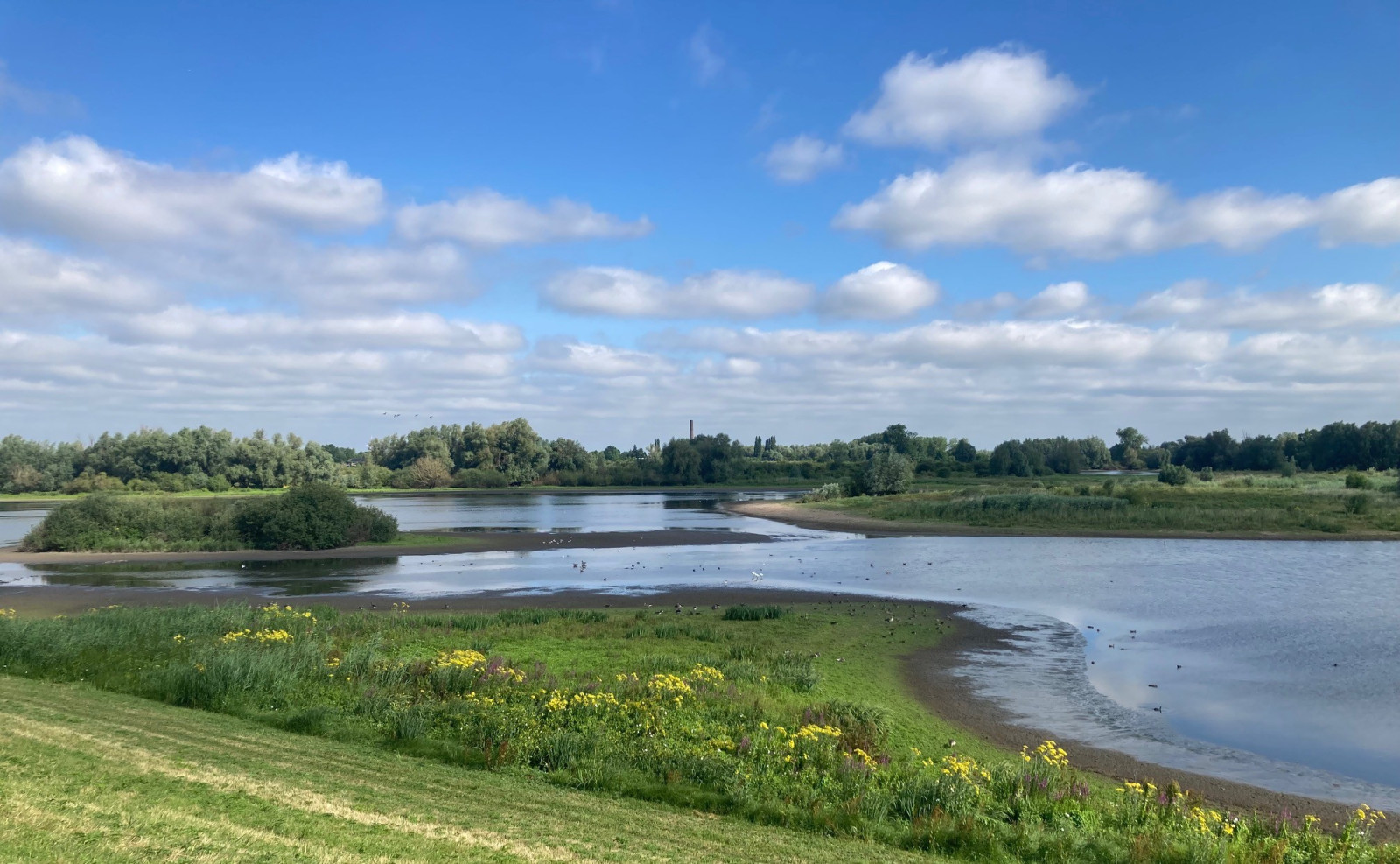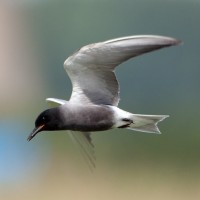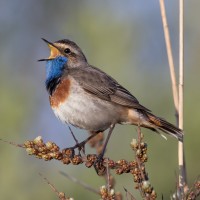Description
Where the River Rhine enters The Netherlands, the name of the river changes to Waal. The 'Oude Waal’ means the 'Old Waal’. It is a shallow old river arm which attracts many birds all year round. It’s located close to the city of Nijmegen and you can walk to the Oude Waal easily from the city. On the water and in the surrounding thickets lots of nice birds can be found. During migration everything can turn up here. From Black Stork to Caspian Tern, numerous waders, herons, ducks and geese. The special attraction are the nesting Black Tern. You can get pretty close to the breeding birds. They don’t really care about you, because there is ten meters of water between you and them. An ideal spot for photographers. The area is also good for Eurasian Spoonbill, Common Kingfisher, Common Cuckoo, Grasshopper Warbler, European Stonechat, Marsh Warbler, European Goldfinch, Linnet, Eurasian Kestrel. A recently created new riverarm just north of de Oude Waal houses Sand Martin.
Bluethroat and sometimes Bearded Tit are most easily seen in the reeds in front of the hamlet of Tiengeboden. In winter you can see massive amounts of Greylag Goose and Greater White-fronted Goose on the open water, and lots of different kind of ducks. Smew en Goosander are regular wintervisitors. Don’t forget to look out for Common Kingfisher and Grey Wagtail around the ‘Hollands-Duits gemaal’ (an old pumping station) and at the fish ladder running behind it. A couple of years ago a White-throated Dipper resided here all winter.
_________________________
Nederlands: De Oude Waal is een ondiepe oude rivierarm van de Waal die het hele jaar door veel vogels trekt. Het gebied ligt vlakbij de stad Nijmegen en je loopt zo vanuit de stad zo naar de Oude Waal. Op het water en in het omliggende struikachtige gebied zijn veel leuke vogels te vinden. Tijdens de vogeltrek kan hier van alles opduiken. Van Black Stork tot Caspian Tern, talloze steltlopers, reigers, eenden en ganzen. De bijzondere attractie zijn de nestelende Black Tern. Je kunt vrij dicht bij de zwarte stens komen. Dat kan zonder verstoring, want er zit meer dan tien meter water tussen jou en hen. Een ideale plek ook voor fotografen. Het gebied is ook goed voor Eurasian Spoonbill, Common Kingfisher, Common Cuckoo, Grasshopper Warbler, Marsh Warbler, European Goldfinch, Linnet, European Stonechat, Eurasian Kestrel. Een recentelijk aangelegde nieuwe rivierarm aan de noordkant van de Oude Waal herbergt vaak wat nesten van de Sand Martin en is vooral interessant als het water er laag staat. Dan kun je er Common Shelduck, Little Ringed Plover, White Wagtail (soms grote groepen) en tijdens de vogeltrek soms Green Sandpiper en Common Greenshank aantreffen.
Bluethroat en soms Bearded Tit zijn het gemakkelijkst te zien in het riet voor het gehucht Tiengeboden. In de winter kun je verder enorme hoeveelheden Greylag Goose en Greater White-fronted Goose op het open water zien, en veel verschillende soorten eenden. Smew en Goosander zijn vaste winterbezoekers. Vergeet niet uit te kijken naar Common Kingfisher en Grey Wagtail rond het ‘Hollands-Duits gemaal’ en bij de daarachter lopende vispassage. Een paar jaar geleden verbleef hier de hele winter een White-throated Dipper.
Details
Access
You can cycle around the entire wetland, or do it by foot. It’s about a 6 km circular walk. You can also take a shortcut (see the map). If you walk from the city, the best place to start your walk is under the Waal-bridge at the waterfront in Nijmegen. From there a small bridge (1) takes you directly into nature. But before you leave, check out the arches of the big Waal-bridge where Peregrine Falcon often are resting. After crossing the small bridge the walk starts. First it is a narrow path and later on a paved road that leads you through the scrubby fields (2) on the north side. You make a loop and return back to the city via the southside of the wetland. From there you walk on a high dyke with excellent views on the Oude Waal. The first part when you return are the reedlands (3) at the hamlet of Tiengeboden, with Bluethroat, Reed Bunting and if you are very lucky Great Bittern and Bearded Tit. After the reedbeds you come to the open water. That’s where the Black Tern nest (4) and many waterbirds can be seen. Pay special attention to the small island (5) with bushes that you find halfway. Depending on the waterlevel, there are always some special birds to be seen here. Here the birds can be at a distance, so a scope is handy. After that you pass the café/restaurant Oude Waal, which has a terrace overlooking the Oude Waal. If you continue at the end the Holland-Duits Gemaal (6) always deserves a check on birds. From the Hollands-Duits Gemaal it’s only a 5-minute walk back to the city.
If you choose to explore The Oude Waal by bike, then start at the Hollands-Duits gemaal, and take the first paved road (Vlietberg) on your left. A small part of the route is unpaved, but still easy to do by bike. If your arrive by car, the best place to park and start is at the Parking marked on the map.
_________________________
Nederlands: Je kunt rondom het hele moerasgebied fietsen of lopen. Het is een rondwandeling van ongeveer 6 km. Je kunt ook een kortere weg nemen (zie de kaart). Als je vanuit de stad wandelt, kun je je wandeling het beste beginnen onder de Waalbrug in Nijmegen. Van daaruit brengt een kleine voetgangersbrug (1) je rechtstreeks de natuur in. Maar bekijk voordat je vertrekt de bogen van de Waalbrug waar bovenop vaak een Peregrine Falcon rust. Na het oversteken van de kleine brug begint de wandeling. Eerst is het een smal pad en later een verharde weg die je door de struikachtige velden (2) aan de noordkant leidt. Je maakt een lus en keert via de zuidkant van de Oude Waal terug naar de stad. Van daaruit loop je over een hoge dijk met prachtig uitzicht op de Oude Waal. Er is langs dat stuk wel veel verkeer en vooral veel fietsers, dus pas een beetje op. Het eerste deel als je terugkeert kom je langs de rietvelden (3) bij het gehucht Tiengeboden, met Bluethroat, Reed Bunting en als je geluk hebt Great Bittern en Bearded Tit. Na de rietvelden kom je bij het open water. Dat is waar de Black Tern nestelt (4) en veel watervogels te zien zijn. Check ook het kleine eiland met struiken (5) dat je halverwege aantreft. Afhankelijk van het waterpeil zijn hier altijd wel bijzondere vogels te zien en in de zomer vaak rustende Eurasian Spoonbill. Hier kunnen de vogels behoorlijk ver weg zitten, dus een telescoop kan handig zijn. Daarna passeer je café-restaurant Oude Waal, dat een terras heeft met uitzicht op het gebied. Als je vanaf het restaurant naar het Holland-Duits Gemaal (6) loopt, doe daar dan altijd nog even een check op vogels. Vanaf het Hollands-Duits Gemaal is het slechts 5 minuten lopen terug naar de stad.
Kies je ervoor om de Oude Waal op de fiets te verkennen, start dan bij de Hollands-Duits gemaal en neem de eerste verharde weg (Vlietberg) aan je linkerhand. Een klein deel van de route is onverhard, maar toch goed te doen met de fiets. Als je met de auto komt, kun je het beste parkeren en starten bij de parkeerplaats die op de kaart staat aangegeven. Met een OV-fiets vanaf station Nijmegen is het ongeveer 5 minuten fietsen naar het begin van de route.



.jpg)